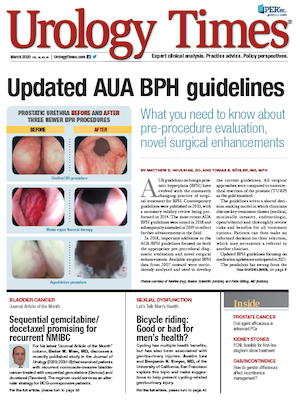Publication
Article
Urology Times Journal
Pharmacotherapy reduces recurrence risk for aggressive stone disease
Author(s):
Pharmacotherapy for reducing risk of stone recurrence is best reserved for patients with more aggressive disease who are at higher risk for another stone-related event, said Brett A. Johnson, MD, at the 2019 World Congress of Endourology and SWL in Abu Dhabi.
Pharmacotherapy for reducing risk of stone recurrence is best reserved for patients with more aggressive disease who are at higher risk for another stone-related event, said Brett A. Johnson, MD, at the 2019 World Congress of Endourology and SWL in Abu Dhabi.
His statement was based on the findings of a retrospective study that compared the risk of stone recurrence between patients managed with pharmacotherapy versus conservative therapy while controlling for disease severity.
“Pharmacotherapy for stone prevention in stone formers has proven effective, but compliance remains poor, primarily due to side effects. Our study aimed to determine if better patient risk stratification may help delineate what patients are most likely to benefit from pharmacotherapy,” said Dr. Johnson, assistant professor of urology, UT Southwestern Medical Center, Dallas.
“Our analyses showed a benefit of pharmacotherapy for delaying stone-related events in patients with a strong history of stones, but indicate that conservative therapy is likely to be as effective in lower risk patients.”
Also see: Stone management often falls short
The study pooled data from four academic centers that are participants in the Multicenter collaboration to Study Treatment Outcomes in Nephrolithiasis Evaluation (MSTONE). The centers include UT Southwestern, the University of Wisconsin, Madison, Vanderbilt University, Nashville, TN, and the University of Iowa, Iowa City.
It included 245 patients seen in the clinic for a stone event between July 2001 and April 2015, were managed with pharmacotherapy or conservative therapy comprised of fluid intake and dietary recommendations, and had a minimum follow-up of 1 year. Patients who started on conservative therapy and were switched to medical therapy were included in the pharmacotherapy group.
The patients were stratified into three risk groups according to the number of previous spontaneously passed stones: low risk, 0; moderate risk, ≤10; high risk, >10. The population included 62 low-risk patients, 147 in the intermediate-risk group, and 36 high-risk patients. The percentage of patients being treated with pharmacotherapy within the three risk groups was 48%, 64%, and 78%, respectively.
“Because this was not a randomized controlled trial, we recognized that patients who are at higher risk for a subsequent stone event would be managed more aggressively. To adjust for that difference, we stratified patients into risk groups taking into account their previous stone issues,” Dr. Johnson explained.
Next: Rate of new stone events lower in pharmacotherapy groupRate of new stone events lower in pharmacotherapy group
Median follow-up for the entire population was 29 months and similar across risk groups. Treatment groups were compared for the rate of stone events, which included new stone formation, stone growth, or an acute stone episode. In the overall population, the rate of new stone events was lower in the pharmacotherapy group than among patients managed conservatively (66% vs. 74%), but the difference was not statistically significant.
When the analysis was done for each risk group, the stone event rate was consistently lower among patients prescribed pharmacotherapy compared with those managed conservatively. Again, none of the differences between management groups achieved statistical significance for overall stone event rate.
“However, when analyzing stone event-free survival, pharmacotherapy demonstrated greater improvement for intermediate and higher risk patients. Pharmacotherapy increased the 30-month stone-free survival rate by 32% and 20% in the high-risk and intermediate-risk patients, respectively,” said Dr. Johnson.
Read:Stone moves to kidney during URS; how should I bill?
The Kaplan-Meier analysis of 30-month stone event-free survival rate showed a statistically significant benefit of medical therapy compared with conservative therapy for delaying a recurrent stone event in the overall population (58% vs. 46%, p=.006) as well as in the intermediate-risk group (65% vs. 45%, p=.005). There was a trend toward statistical significance in the high-risk group (49% vs. 17%, p=.099).
“The intermediate-risk group had the highest number of patients and therefore had greater power for detecting a statistically significant difference between management groups,” commented Dr. Johnson.
“However, the greatest magnitude difference was observed in the high-risk group.”
Dr. Johnson noted that the study did not account for treatment compliance, but that may not be an important limitation considering that patient compliance is poor with both pharmacotherapy and dietary recommendations for preventing stone recurrence. In addition, it did not stratify patients based on 24-hour urine parameters because the data were not available for all patients.
“It is not always possible to get a 24-hour urine specimen from stone patients, and so we took a very top-down view that considered what basic approach might be done in the clinic to manage patients with stone disease,” Dr. Johnson told Urology Times.
“We feel our study has several strengths that include a relatively large population, a reasonably long follow-up duration, and the ability to control for disease severity.”

Newsletter
Stay current with the latest urology news and practice-changing insights — sign up now for the essential updates every urologist needs.




























